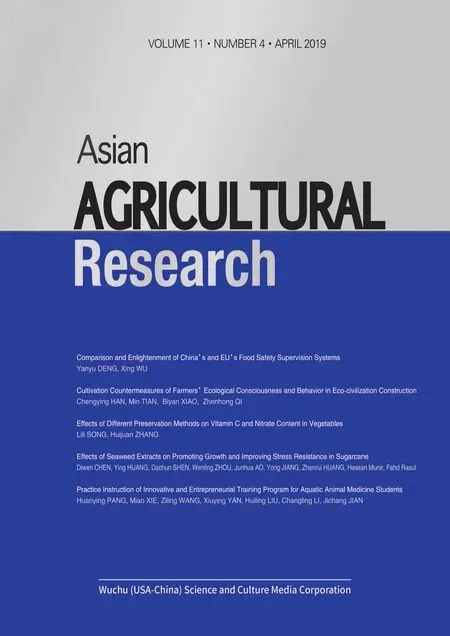Survey on Factors Influencing the Decline in Chicken Consumption of Urban Residents in Liaoning Province
2019-05-24NaDINGChunlingPAN2ZheZHANGShanshanGAO
Na DING, Chunling PAN2*, Zhe ZHANG, Shanshan GAO
1. HE University, Shenyang 110163, China; 2. Shenyang Agricultural University, Shenyang 110866, China
Abstract In order to analyze the key factors influencing the decline in chicken consumption in urban residents in Liaoning Province since 2008, and understand the characteristics of chicken consumption behavior of consumers in Liaoning Province, this paper used questionnaire survey to analyze the consumption of chicken and chicken products in Shenyang, Dalian, Anshan and Benxi of Liaoning Province. According to the analysis, the main reason for the decline in the chicken consumption is that the growth of pork consumption quickly replaced part of chicken consumption, which may be caused by the consumption preference of local residents. Another important reason is the frequent occurrence of incidents of chicken food quality and safety, leading to the worry about the safety of chicken food and accordingly reducing the times of chicken consumption. In addition, compared with the pork, beef, and mutton, the taste of chicken is slightly worse. In the period of consumption upgrading, the growth and decline of a product is a common phenomenon.
Key words Chicken and chicken products, Consumption quantity, Consumption characteristics, Influencing factors
1 Introduction
With its high quality and low price, chicken has always been an indispensable food on the dining table of Chinese residents over the years. Besides, with people’s gradual recognition of healthy nutrition of chicken (high protein and low fat), high breeding efficiency, low carbon dioxide emissions and other advantages, the consumption of chicken is showing an increasing trend year by year. In 2004, the world’s chicken consumption was 66.44 million t. By 2014, it had soared to 95.157 million t, with an average compound annual growth rate of more than 3.5%. As a large consumer of chicken, China’s chicken consumption accounted for 16% of the world’s total in 2015, ranking second in the world[1].
However, in recent years, the domestic chicken consumption has not been optimistic. The per capita chicken consumption is declining in many provinces, including Liaoning Province. According to theStatisticalYearbookofLiaoningProvince, the per capita chicken consumption of urban residents in Liaoning Province was 5.27 kg in 2008, which dropped to 4.89 kg in 2012. By 2015, the per capita chicken consumption in Liaoning Province was as low as 3.75 kg. In order to analyze the reasons for the continuous decline in chicken consumption, and find out the factors influencing the continuous decline in chicken consumption willingness in Liaoning Province, we organized a team of students of animal husbandry discipline to survey the consumption of chicken and processed products in four cities in Liaoning Province, in the hope of providing a basis for the reasonable development of the production and processing industry of broilers and policy regulation.
2 General information of the survey
2.1 Data source and sample characteristicsThis survey selected consumers from relatively developed cities Shenyang, Dalian, Anshan and Benxi in Liaoning Province as the research object, and adopted a random questionnaire. The questionnaires were distributed in areas where fresh and non-staple foods are sold, such as supermarkets, farmers’ markets, and country fairs. Each city was distributed with 150 copies of questionnaires and 544 valid questionnaires were collected. The valid response rate was 90.67%. The statistical characteristics of the surveyed objects are listed in Table 1. In terms of the sample distribution, the distribution of various characteristics is relatively uniform, which is more in line with the basic social conditions, thus the obtained data are reasonable.
Table 1 Statistical characteristics of age, income, and educational level of the surveyed objects
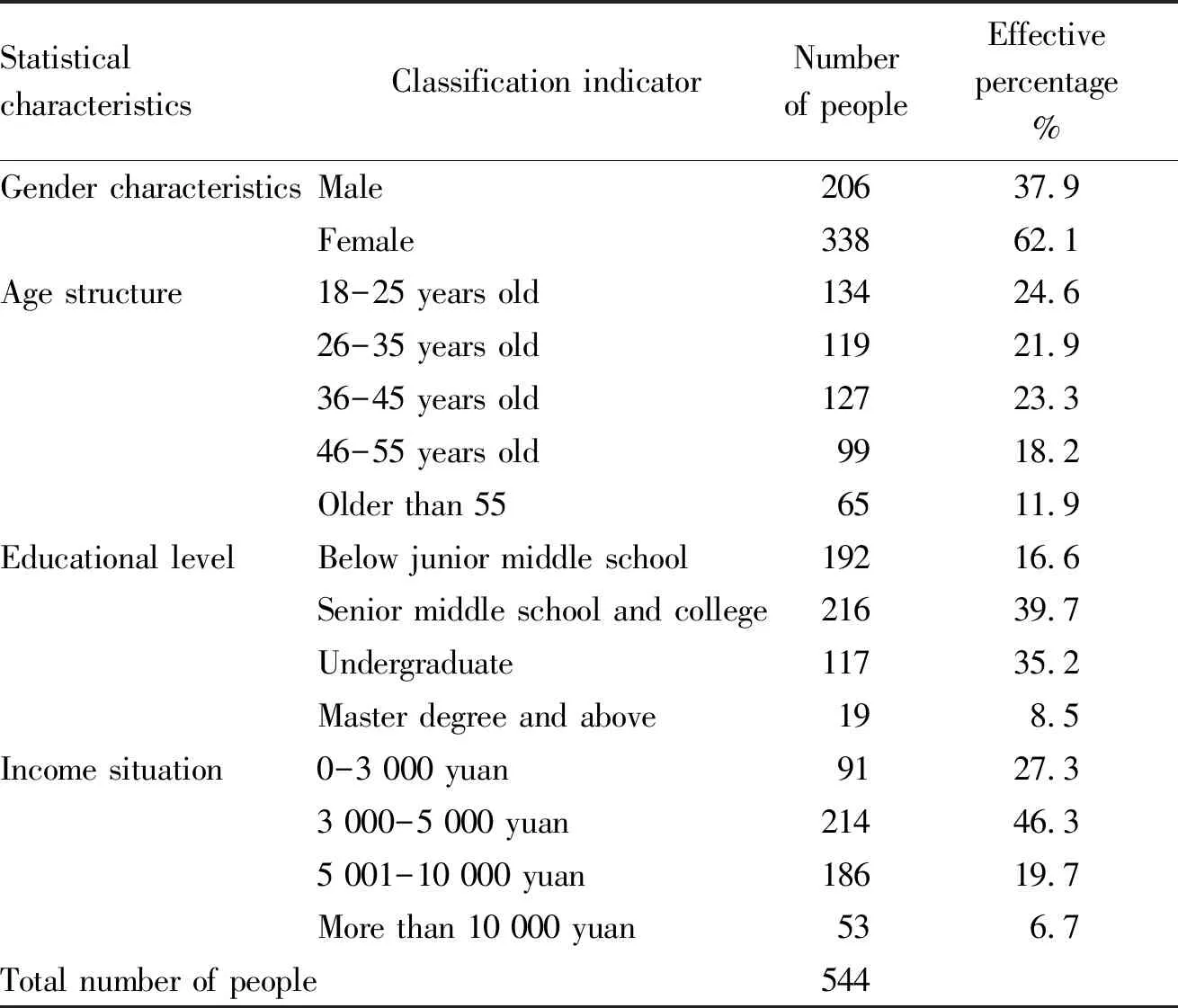
StatisticalcharacteristicsClassification indicatorNumberof peopleEffectivepercentage%Gender characteristicsMale20637.9Female33862.1Age structure18-25 years old13424.626-35 years old11921.936-45 years old12723.346-55 years old9918.2Older than 556511.9Educational levelBelow junior middle school19216.6Senior middle school and college21639.7Undergraduate11735.2Master degree and above198.5Income situation0-3 000 yuan9127.33 000-5 000 yuan21446.35 001-10 000 yuan18619.7More than 10 000 yuan536.7Total number of people544
2.2 Design of questionnaire contentAccording to needs of the research, we divided the consumption of chicken and chicken products into two aspects: the survey of consumption behavior characteristics of chicken and chicken products and the survey of consumption influencing factors[2-5].
The survey of consumption behavior characteristics of chicken and chicken products mainly included the number of times consumers weekly consume chicken and chicken products,the number of times of consuming various meat products, and the categories and channels of consumers buying chicken and chicken products The survey of consumption influencing factors mainly included factors that consumers care about when buying chicken and chicken products, quality and safety issues, understanding of chicken quality and brands, and consumption willingness for chicken and chicken products.
3 Statistics and analysis
3.1 Consumption behavior characteristics of chicken and chicken products
3.1.1Weekly frequency of consumption of chicken and chicken products. According to our survey, the weekly frequency of consumption of chicken and chicken products is mainly influenced by the age and income, there is no significant difference in the educational level. From Fig.1, it can be known that consumers who are between the ages of 18-35 and whose monthly income is below 3 000 yuan are the main group of chicken consumption. Their weekly frequency of consumption of chicken is more than three times, significantly higher than that of other people. There are two possible reasons. (i) This group of people has the largest proportion of singles, they pursue more convenient, simple, and inexpensive foods, while the advantages of chicken are more prominent than other meat products. (ii) In this group of people, students account for the largest proportion, the canteens and fast food restaurants are the main places for their daily diet, and the chickens have the absolute advantage compared with pork, beef and mutton, thus chicken is their first choice. In the consumers who are older than 36 and have the monthly income more than 3 000 yuan, the consumption of chicken gradually declines possibly because (i) most of them have established families and care more about the balance of nutrition, (ii) their income is higher, they have more choices for meat products and have higher demands for meat taste, and (iii) they care much about the food safety, and the negative report of chicken food will directly influence their consumption choice.

Note: a. Different age; b. Different income.
Fig.1 Weekly frequency of different ages and income of consumers in consumption of chicken and chicken products
3.1.2Categories of chicken and chicken products commonly bought by consumers. According to our survey, the chicken consumption is mainly divided into two categories: fresh chicken and chicken products. The specific categories are as follows: fresh chicken includes live chicken, whole cold chicken or frozen chicken, split chicken, and fresh chicken products. The split chicken refers to the chicken breast, chicken legs, chicken wings, chicken head, chicken neck and other split parts. Fresh chicken products refer to fresh chicken products with simple processing. Chicken products include fully cooked or half cooked chicken products such as smoked, fried, marinated or salted, and sausages. From Table 1, consumers in Liaoning Province prefer the split chicken when they purchase chicken. This consumption habit is significantly different from the preference of the consumers in southeastern provinces (Guangdong, Fujian,etc.), southern consumers often buy live chicken or whole chicken[2]. This difference may be directly related to the apparently different diet habits. In the daily diet of southern residents, it is more common to use whole chicken to make soup. In the northeastern areas, there is no such habit of eating soup every meal. The way to eat chicken is mainly marinating, salting or stew, so the frequency of eating chicken is not as frequent as in the southern areas. Northern consumers prefer seasoned and fried chicken, and many consumers like smoked, marinated or salted chicken.
3.1.3Common channels of buying chicken and chicken products. From Table 2, it can be seen that farmers’ market is the main channel of consumers buying fresh chicken. More than 50% consumers buy fresh chicken from farmers’ market. Supermarket is the second largest place for consumers buying chicken. Although the Internet is convenient and fast, because it is not normative as the former two, the consumers who choose this Internet are still very few. Street pedlars usually conduct live poultry transactions. With the gradual strengthening of live poultry transaction management in Liaoning Province, unlicensed street pedlars will be further restricted, and the number of consumers who purchase chicken through such channel will definitely drop. For the consumption place of chicken products, the supermarket is still the first choice of most consumers, but the proportion advantage is not prominent. In fact, however, the number of consumers who choose pedlars is not small, possibly because nearly half of the people surveyed are under 35 years old. This group of consumers have a higher degree of acceptance to the fried chicken products fried chicken products (such as chicken fillets and chicken steaks) at street pedlars.
Table 2 Survey of categories of chicken and chicken products preferred by consumers
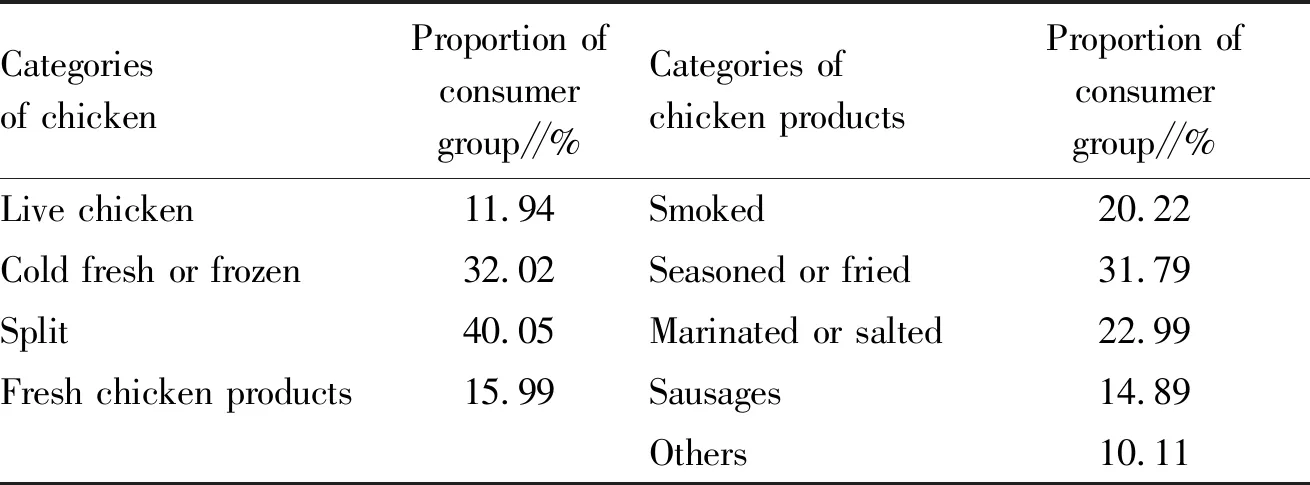
Categoriesof chickenProportion ofconsumergroup∥%Categories ofchicken productsProportion ofconsumergroup∥%Live chicken11.94Smoked 20.22Cold fresh or frozen32.02Seasoned or fried31.79Split40.05Marinated or salted22.99Fresh chicken products15.99Sausages 14.89Others10.11
Table 3 Survey of channels of buying chicken and chicken products

Place ofpurchaseFreshchicken∥%Place of purchaseChickenproducts∥%Farmers market56.07Supermarket35.85Supermarket34.87Street pedlars19.12Internet4.96Restaurant or fast food restaurant29.04Street pedlars4.10Canteen15.99
3.1.4Survey of weekly frequency of buying various meat products. According to the survey results (Table 4), in the consumption structure of meats, urban residents of Liaoning Province mainly buy pork. In terms of the weekly frequency of buying various meat products, more than half consumers buy pork every day, while only 7.3% consumers buy chicken every day. According to the data ofLiaoningStatisticalYearbook, the proportion of pork consumption in urban residents of Liaoning Province was 68.62% in 2015; it was 56.46% in 2008, it was 62.6% in 2011, and it rose to 69.3% in 2013. During these seven years, the proportion of pork consumption in Liaoning Province increased by more than 10%. In 2008, beef and mutton consumption accounted for 23.74% of total meat consumption, it was 19.08% in 2011, 17.13% and 17.63% in 2013 and 2015, respectively. The proportion of beef and mutton consumption declined by about 6% in the past seven years. In 2008, the chicken consumption accounted for 19.84% of total meat consumption, it was 18.25% and 17.13% in 2011 and 2012, respectively, it dropped to 13.62% in 2013 and 13.76% in 2015. The proportion of chicken consumption declined by about 6% in the past seven years. These indicate the sharp increase in pork consumption has replaced chicken consumption, which is an important reason for the decline in the chicken consumption of urban residents in Liaoning Province.
Table 4 Weekly frequency of consumption of meat products

FrequencyPork∥%Beef andmutton∥%Chicken∥%Other meatproducts∥%0-2 times9.6067.6051.6092.103-5 times31.6027.1041.106.806-10 times58.805.307.301.10
3.2 Survey of factors influencing consumption of chicken and chicken products
3.2.1Main considerations in buying chicken and chicken products. According to Fig.2, when buying chicken and chicken products, consumers mainly consider quality and safety, price, and taste. About 70% consumers take the quality and safety as the first consideration, nearly half consumers state that they would consider the price, and about 40% consumers care more about the taste of chicken. These indicate that quality and safety are major consideration for consumers buying meat products. The price is a distinct advantage of chicken, other meat products can not be compared with it, so it is a favorable factor to promote chicken consumption. In terms of the taste of chicken, different consumers have different comments. Since the breeding of chicken in Liaoning Province is mainly white feather broiler, the consumption of chicken is also mainly white feather broiler. According to the meat features of white feather broiler, the taste of cooked and stewed chicken is poor, while the taste of fried and smoked and salted chicken is good, thus the consumers have different comments to the taste of chicken. Consumers care little about the nutritional value and brand of chicken, and only 20% of consumers will pay attention to the nutritional value of chicken when they buy chicken products. For the famous brand enterprises of broiler breeding and chicken processing industry, only 6.8% consumers stated that they would consider the brand. By comparison, consumers would pay attention to the brands when buying the pork[6]. This is possibly because that the propaganda of broiler breeding and processing enterprises is much weaker than that of the swine breeding enterprises.
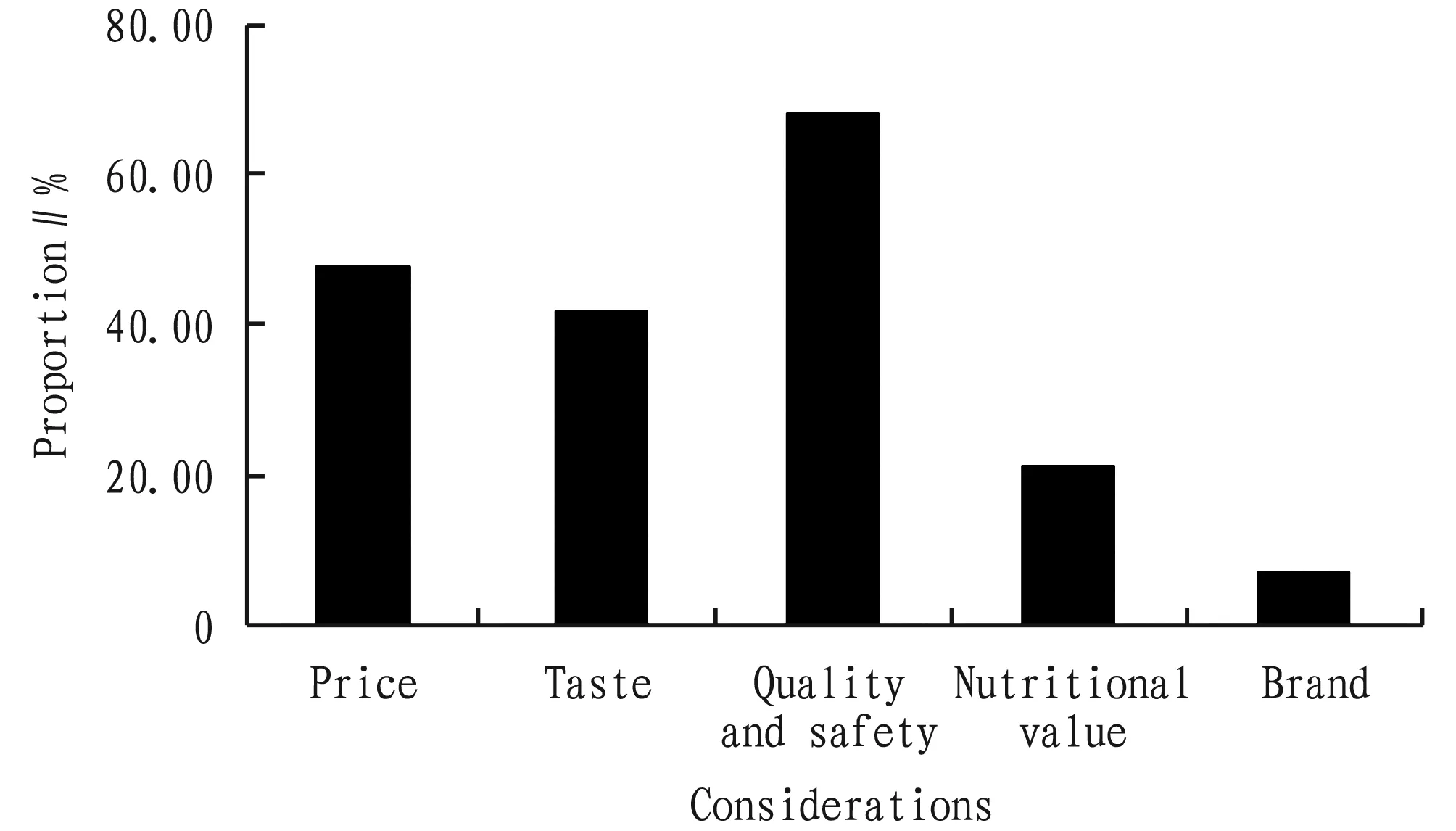
Fig.2 Main considerations of consumers in buying chicken and chicken products
3.2.2Mainly considering the quality and safety of chicken and chicken products. From Fig.3, it can be seen that more than 90% consumers care about the poultry diseases in terms of the quality and safety. In recent years, H7N9 influenza virus is the largest influence in the poultry diseases. Every winter and early spring is the period of high incidence of H7N9 virus. During this period, live poultry transaction in many areas will be banned, and consumption of chicken such as frozen chicken and cold fresh chicken will be greatly influenced. Apart from the poultry diseases, consumers also care about the sanitation and "fast-grown chicken" in terms of the quality and safety of chicken. The sanitation safety mainly refers to the chicken source and health problems in the processing of cooked chicken food products. In recent years, the news about "dirty workshop" and "dirty processing" has been reported frequently, which will inevitably lead consumers to pay high attention to it. The close attention to the problem of fast-grown chicken may be due to the incidence of "fast-grown chicken" of Shanxi Suhai Group Co., Ltd. in 2012[7]. In fact, the resistance and panic of consumers about "fast-grown chicken" is a misunderstanding of broiler breeding. Slaughtering of broiler in 45 d is a normal situation in the world. According to FAO statistics, in 2012, most of the world’s commercial broilers were slaughtered in 42-48 d; in China, in the provisions ofProductionTechniqueCriterionforCommercialBroileramended in 2005, it has clearly stated that broiler breeding for 42 d and weight reaches 2.42 kg can be delivered for sale. Five years after the "fast-grown chicken" incident, consumers still care about this issue and worry about it, fully reflecting that the propaganda of broiler breeding enterprises is not enough, so that the misunderstanding still exists. Besides, the problem of "drug residue" in broilers is also a hot issue of food quality and safety, due to the existence of this problem in other meats, consumers’ attention to "drug residue" is not as high as that of diseases such as diseases and fast-grown chicken. The factors with the lowest consideration is the storage and transportation of chicken products. Only about 10% consumers state that they would consider this factor when buying chicken products.
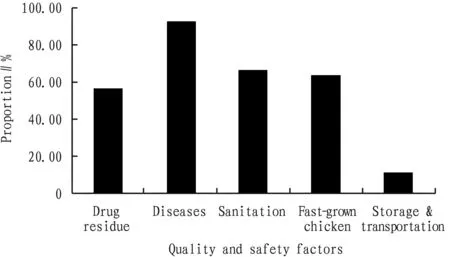
Fig.3 Quality and safety factors consumers care about most
3.2.3Changes in purchase willingness in the event of an outbreak of chicken quality and safety. As can be seen from Fig.4, when chicken quality and safety related incidents occur, less than one-third of consumers are not influenced in the chicken consumption; nearly 20% of consumers will have great changes and they will never buy again; 24% of consumers are holding a wait-and-see attitude and will decide whether to continue eating chicken according to the subsequent development of the event; the remaining one third of consumers will still buy chicken and chicken products but will still reduce the times of purchase. Thus, it indicates that the quality and safety directly lead to the sharp decline of chicken sales. According to theStatisticalYearbookofLiaoningProvince, the year with the most significant decline in the chicken consumption in Liaoning Province was 2013, which dropped from 4.89 kg in 2012 to 3.76 kg, a decline of more than 20%. The "fast-grown chicken" event broke out in November, 2011. Later, the chicken consumption sharply declined, and the white feather broiler breeding in Liaoning Province suffered a great hit, and it suffered losses for many consecutive years. Until 2016, the situation changed better.
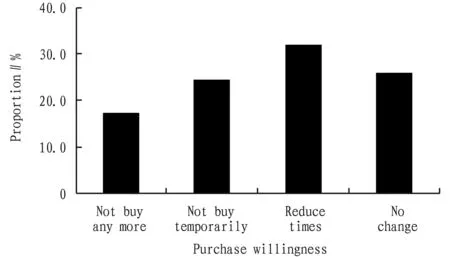
Fig.4 Changes in the purchase willingness after the occurrence of quality and safety event
3.2.4Factors improving the purchase willingness. From the above survey results, it is easy to see that food safety risk will lead to the decline in the purchase willingness of chicken consumption. Then, which factors can improve the purchase willingness? From Fig.5, it can be seen that more than 80% of consumers will be willing to increase the times of chicken purchases after confirming that the safety of chicken is higher. Therefore, avoiding food safety risks is the most important factor to improve the purchase willingness. Another factor that can improve the purchase willingness is the price. In any time, the promotion of price to the consumption should not be neglected. Media recommendations and brand effects have a certain role in promoting purchase willingness, and about one third of consumers accept the brands recommended by the media. Relatively speaking, convenience is less attractive to consumers, and only about 5% of consumers are willing to increase the times of purchases because of the convenience.
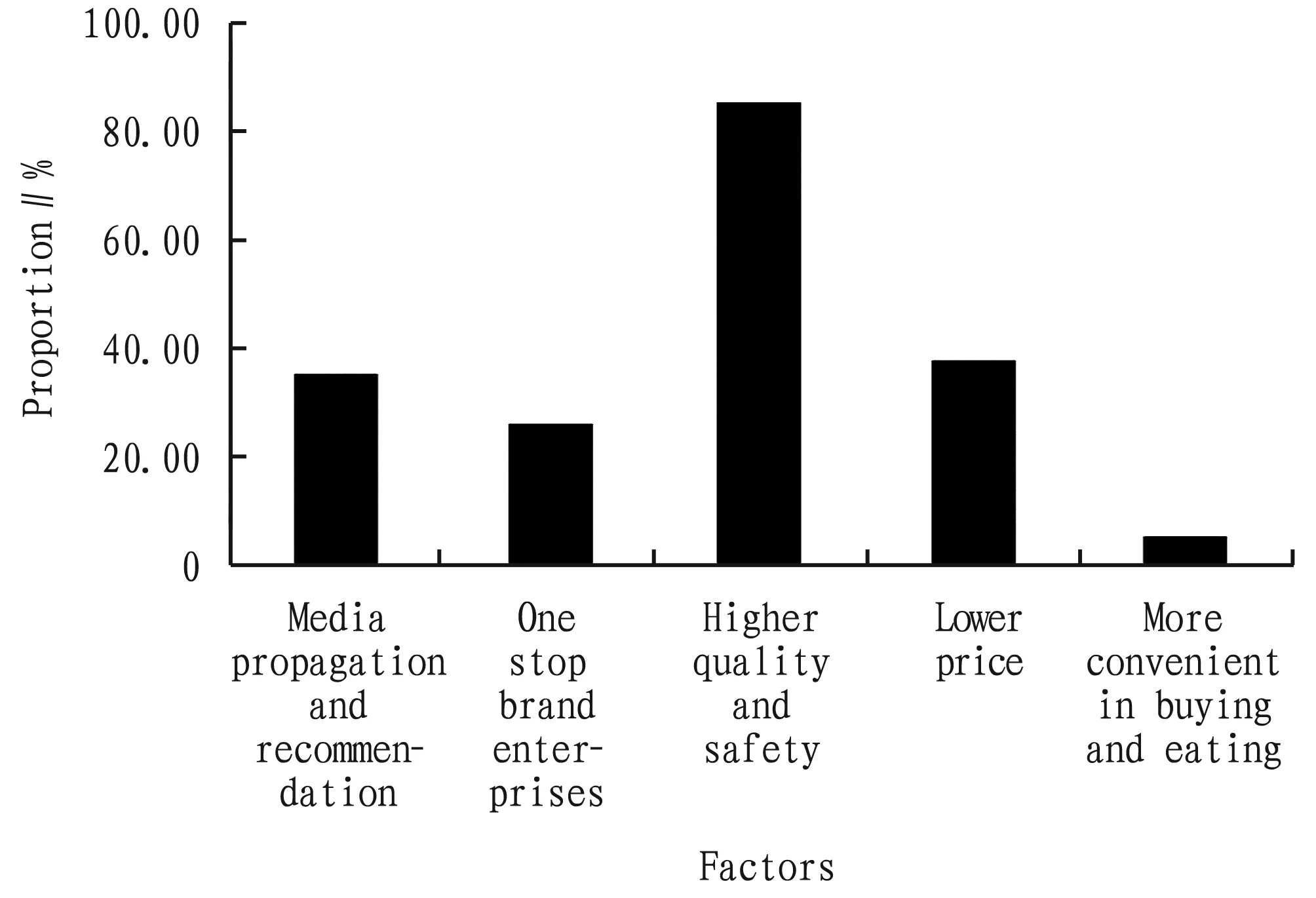
Fig.5 Factors improving purchase willingness
3.2.5Confidence in the quality and safety of chicken foods sold at local markets. In recent years, the quality and safety of chicken products have been reported frequently. These problems will undoubtedly affect the confidence of consumers in eating chicken. From Fig.6, only less than 10% of consumers believe that the current quality and safety of chicken foods have no problem, we can highly rest assured to eat; about one third of consumers think rest assured; more than 40% of consumers have doubts about the chicken quality and safety, they think that the problems have not yet been exposed fully; the rest 13.79% of consumers believe that the current quality and safety of chicken foods have too many problems and it is difficult for use to be assured. These doubts are bound to exert a negative impact on the consumption of chicken. Scully (2003) once pointed out that consumers’ doubt of food safety determines their own consumption behavior, and the panic caused by their doubt will greatly affect food sales and cause huge economic losses[8].
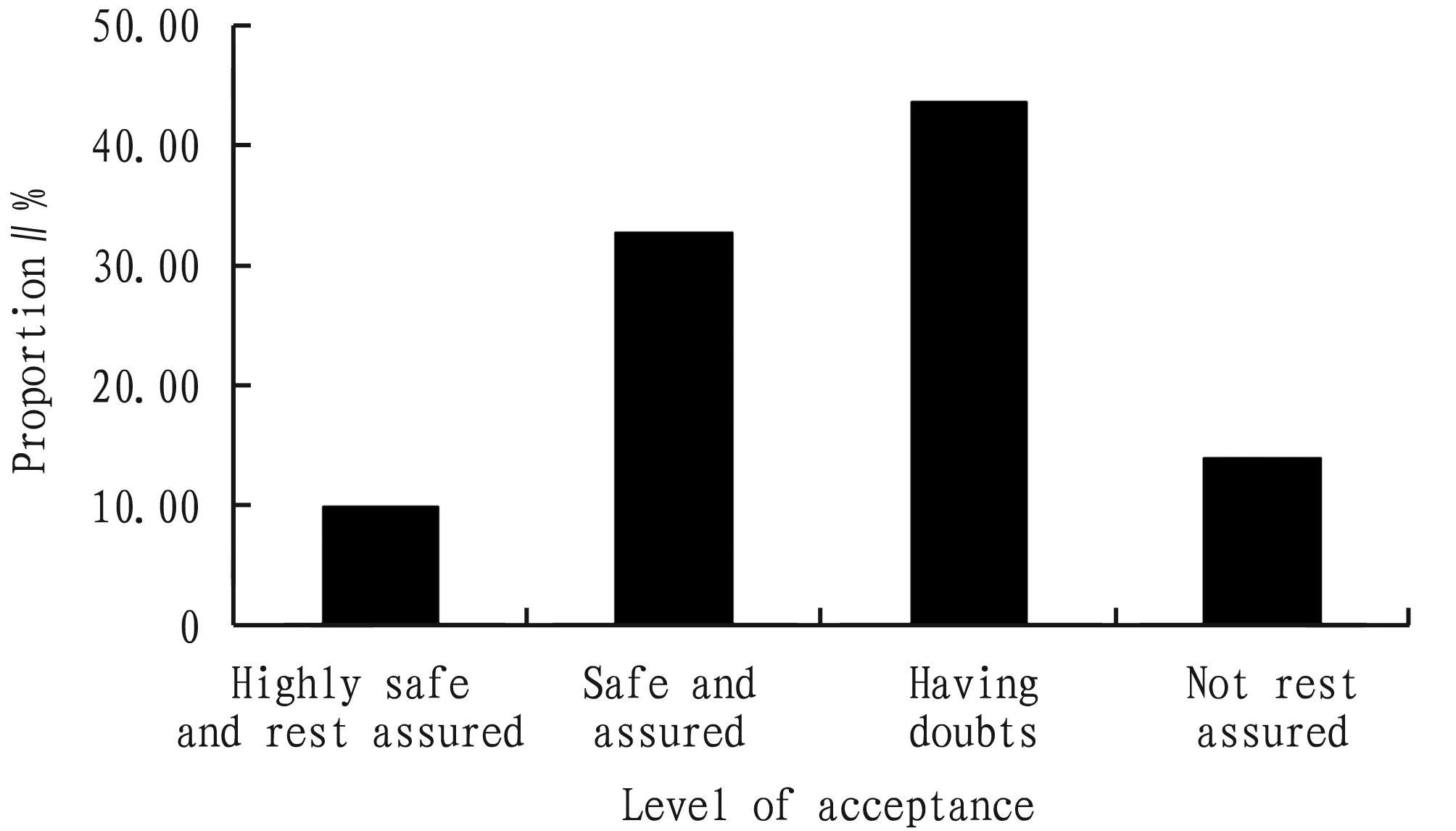
Fig.6 Consumers’ acceptance of chicken quality and safety
3.2.6Consumers’ judgment on the characteristics of safe and reliable chicken. From Fig.7, it can be seen that the highest level of consumer acceptance is the inspection and quarantine report issued by the government, and more than one-third of consumers affirmed this. About one third of consumers showed their recognition of the role of the news media. It can be seen that the advertising effect has a significant role in enhancing consumer confidence. Only about 18% of consumers believe that chicken produced by well-known brands is safe and reliable, and consumers’ recognition of brands is not high. The main reasons may be: (i) broiler breeding enterprises are far less popular with their own brand promotion than the swine breeding enterprises, so the brand effect has not yet been set up in the hearts of consumers; (ii) safety incident of famous swine brands (incidence of Shuanghui Lean Meat Powder, for instance). The lowest consumer recognition is the quality traceability system certification, which may be because the chicken quality traceability system certification has not been widely promoted in China. Many consumers, especially elderly consumers do not understand this system and less apply the system, so the degree of recognition is not high.
3.2.7Reputation of broiler production brands. Nearly half of the consumers are not clear about the famous brands of chicken. Only about one third of consumers know one or two famous companies, and consumers who know three or more chicken brands are less than 15%. Most consumers have no requirements for the brand when buying chicken products, and there is no fixed brand. However, in the survey of reputation of pork brands, 34.9% consumers have fixed pork brands, and many consumers can give two or three brand names[9]. These indicate that there is still a huge gap in the brand effect between chicken and pork.
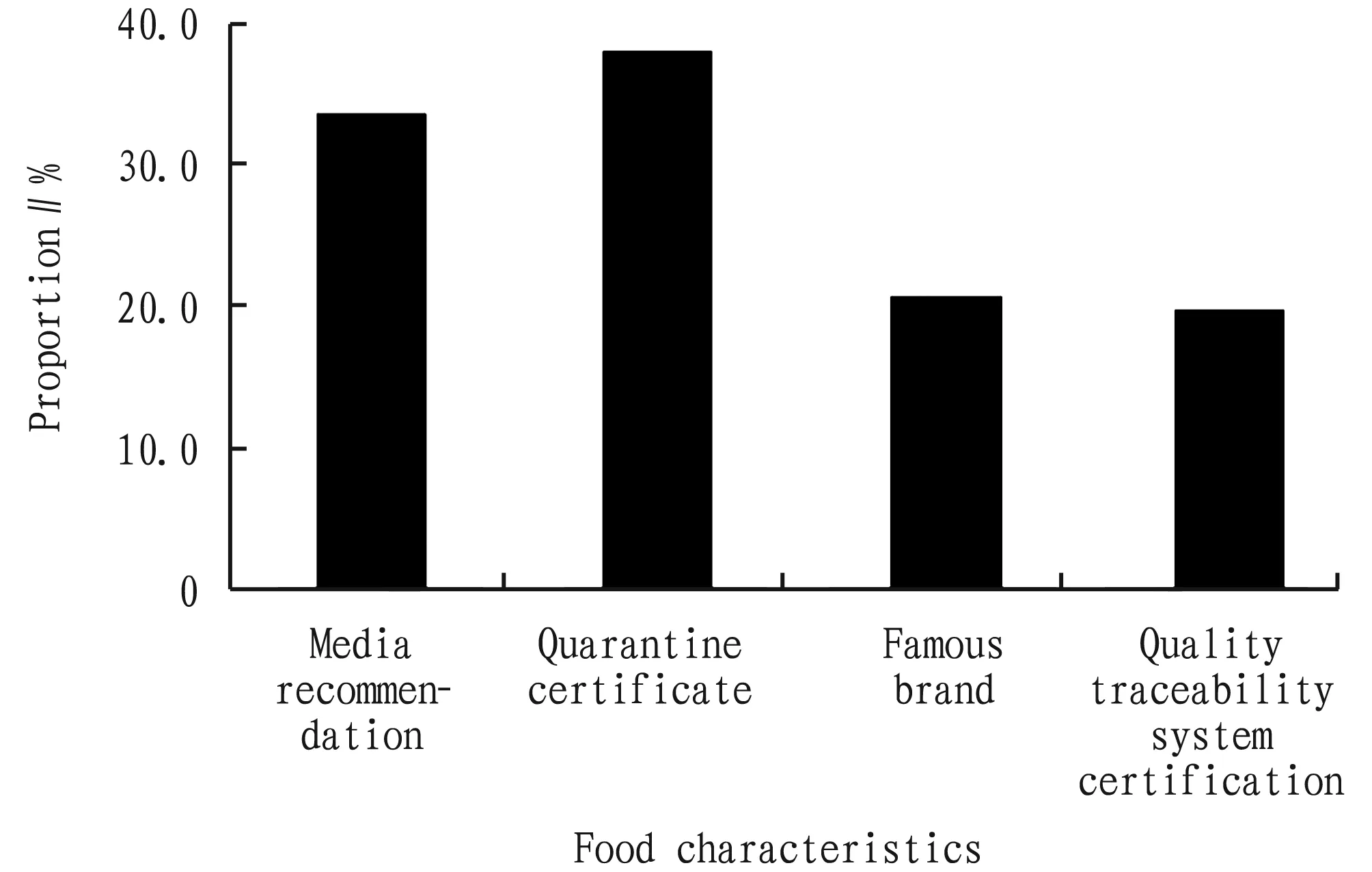
Fig.7 Characteristics of chicken foods believed by consumers
3.2.8Understanding of advantage of chicken quality. As can be seen from Fig.8, nearly 20% of consumers have no understanding of the prominent advantages of chicken quality, only know that chicken prices are much lower than the pork, beef and mutton. Nearly half of consumers know that chicken is healthier than pork, beef and mutton, but they are not clear why it is healthier. Only about one third of consumers clearly know that chicken has the advantages of high protein and low fat, and the nutrition is more comprehensive, and it is better than pork, beef and mutton. Few consumers know that the carbon emissions of broilers during the breeding process are significantly lower than the environmental advantages of pigs, cattle and sheep. Less than 6% people have a comprehensive understanding of cheap, environment-friendly and healthy advantages of chicken. Thus, to promote consumers’ enthusiasm for eating chicken, propagating the quality advantage of chicken will be an important approach for increasing consumers’ willingness to purchase chicken products.
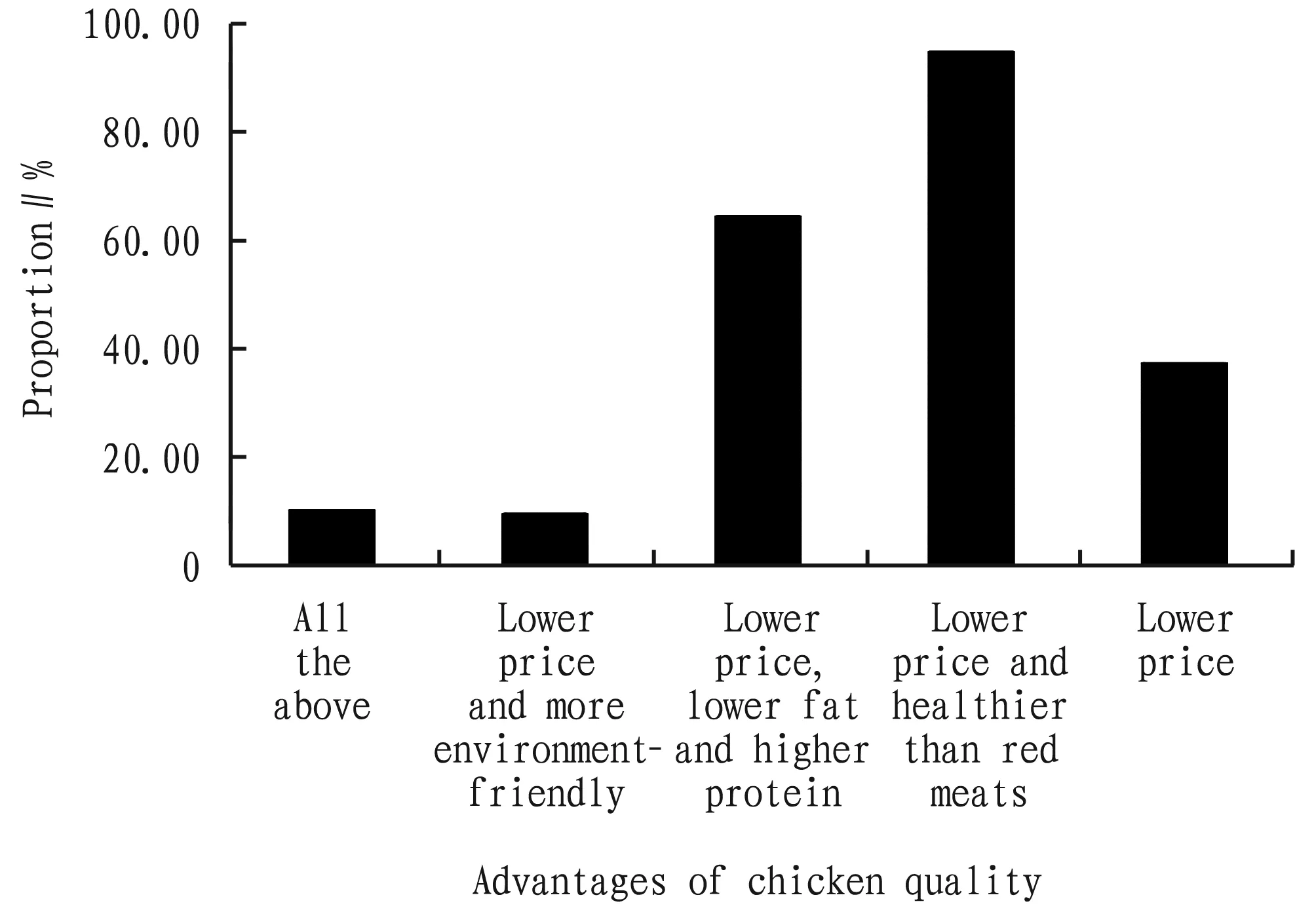
Fig.8 Understanding of advantages of chicken quality
4 Conclusions and recommendations
4.1 ConclusionsAccording to our survey results, the main reasons for the decline in the chicken consumption of urban residents in Liaoning Province are as follows. (i) Pork consumption has increased substantially and takes place of some of the chicken consumption. Among the daily consumption of meat products, the proportion of pork consumption in total meat consumption increased from 56.4% in 2008 to 68.6% in 2015. Especially in 2014, the proportion exceeded 70%, and growth rate exceeded 12%; while chicken consumption dropped about 6% of the total meat consumption. (ii) The quality and safety of chicken and chicken products seriously affect consumers’ consumer confidence, leading to a decline in the chicken consumption. According to our survey, when the chicken quality safety incident broke out, less than one third of consumers will keep their previous eating habits, other consumers will reduce the number of times they eat chicken, and will not buy chicken products for a long time. In November 2012, the "Fast Grown Chicken" incident broke out. In 2013, the per capita consumption of chicken in urban residents in Liaoning Province dropped by 1.13 kg, a decrease of more than 23%. Until 2015, the consumption of chicken still did not increase. During the high incidence of avian influenza every year, live poultry transactions are strictly controlled, and residents’ consumption of chicken will also be affected. (iii) Urban residents in Liaoning Province are concerned about the quality and safety of chicken and chicken products. According to the survey results, more than half of consumers believe that chicken may have different degree of quality and safety problems. Such understanding seriously affects consumers’ enthusiasm for eating chicken and even makes consumers resist the consumption of chicken. (iv) The taste of chicken is slightly poorer than that of pork, beef, and mutton. According to our survey, more than 40% of consumers will consider the taste when they buy meats. White feather broilers have a certain gap between color, flavor, meat tenderness and juiciness compared with pork beef and mutton, especially chicken is not suitable for cooking and stewing. (v) Urban residents in Liaoning Province know very little about the high quality of chicken. From the perspective of nutrition, chicken protein content is 5% higher than pork, while the fat content is only 1/3 of pork, and chicken is rich in all essential amino acids required by the human body. According to the survey results, more than half of consumers do not understand this.
4.2 Recommendations(i) It is recommended to fully explore the desire of main consumption group to buy chicken. The main group of chicken consumption is consumers who are between the ages of 18-35 and whose monthly income is below 3 000 yuan. This group of people is the main force of chicken consumption due to the reasons of economic income, eating habits, eating places In view of these, when promoting and propagating, the production and processing enterprises of chicken and chicken products should focus on the aesthetics, tastes, preferences, cooking methods and media browsing habits of this group, and develop chicken products that better conform to the consumption preferences of this group, apply better strategies and means to attract the attention of the people in this range to achieve the best propagation effect. Besides, despite preferred by consumers, seasoned, smoked, marinated, salted or fried chicken products are worse in the nutritional and healthy aspects. By comparison, southern areas have the habits of using the whole chicken to make soup, which can keep the nutrition of the chicken and the cooking method is very healthy. Therefore, chicken production and processing enterprises may take the chicken cooking culture of southern areas as the promotion and propaganda means to attract consumers in the northeastern areas.
(ii) Chicken production and processing enterprises should strengthen the propaganda of high quality chicken products to attract the consumers to buy chicken products. At present, the meat consumption growth is almost stagnant, chicken consumption is actually competing with pork, beef, and mutton. In such competition, it is not enough for consumers to know only the chicken price. Nutrition and health functions of chicken should be greatly promoted. Liaoning Province is a high-risk province for cerebral thrombosis. Thus, low-fat, high-protein chicken is more suitable for middle-aged and elderly people than high-fat pork. Since consumers generally show a high degree of recognition for inspection and quarantine reports issued by the government and media advertisements, it is recommended to start from these two aspects.
(iii) It is recommended to strengthen the quality and safety monitoring of chicken products, do a good job in the safety and sanitation of chicken foods, and avoid food safety incidents. In particular, it is necessary to eliminate consumers’ prejudice against the fast-grown chicken, and to dispel the consumer’s misunderstanding that the white-feather broilers grow fast because of hormones, to enhance consumers’ confidence in the quality and safety of chicken products.
(iv) Broiler production and processing enterprises should attach great importance to the construction and propaganda of their brand image, to make the brands of chicken enterprises known to all like pork enterprises.
杂志排行
Asian Agricultural Research的其它文章
- Ridge Covering High-yield Cultivation Techniques of Jinhong Apple in Cold Region
- Different Fertilization Modes of Sugarcane in Latosolic Red Soil of Guangxi
- Effects of Seaweed Extracts on Promoting Growth and Improving Stress Resistance in Sugarcane
- Rules of Changes in Soil Nutrients and Enzyme Activities of Larix principis-rupprechtii in Different Forest Ages
- Cultivation Countermeasures of Farmers’ Ecological Consciousness and Behavior in Eco-civilization Construction——A Case Study of Agricultural Waste Recycling
- Risk Assessment and Service Benefit Evaluation of Forestry Meteorological Disasters in Guangxi
